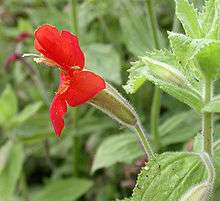Erythranthe cardinalis
| Erythranthe cardinalis | |
|---|---|
 | |
| Scientific classification | |
| Kingdom: | Plantae |
| (unranked): | Angiosperms |
| (unranked): | Eudicots |
| (unranked): | Asterids |
| Order: | Lamiales |
| Family: | Phrymaceae |
| Genus: | Erythranthe |
| Species: | E. cardinalis |
| Binomial name | |
| Erythranthe cardinalis Dougl. ex Benth. | |
Erythranthe cardinalis, the scarlet monkeyflower,[1][2] is a flowering perennial in the family Phrymaceae. Together with other species in Mimulus section Erythranthe, it serves as a model system for studying pollinator-based reproductive isolation. It was formerly known as Mimulus cardinalis.[3][4][5][6]
Description
It is a fairly large, spreading, attractive plant which bears strongly reflexed, nectar-rich red or orange-red flowers and toothed, downy leaves. It is native to the West Coast and Southwestern United States and Baja California, and is generally found at low elevation in moist areas. Occasional populations of yellow-flowered Erythranthe cardinalis (which lack anthocyanin pigments in their corollas) are found in the wild.[7]
Cultivation
Erythranthe cardinalis is cultivated in the horticulture trade and widely available as an ornamental plant for: traditional gardens; natural landscape, native plant, and habitat gardens; and various types of municipal, commercial, and agency sustainable landscape projects. Cultivars come in a range of colors between yellow and red, including the "Santa Cruz Island Gold" variety, originally collected from Santa Cruz Island off the coast of California.
Pollination
Its blooms and large nectar load attract hummingbirds, whose foreheads serve as the pollen transfer surface between flowers. In the area where it overlaps with its sister species, Erythranthe lewisii, reproductive isolation is maintained almost exclusively through pollinator preference.[8]
References
- ↑ "BSBI List 2007". Botanical Society of Britain and Ireland. Archived from the original (xls) on 2015-02-25. Retrieved 2014-10-17.
- ↑ "Mimulus cardinalis". Natural Resources Conservation Service PLANTS Database. USDA. Retrieved 28 January 2016.
- ↑ Barker, W.R.; Nesom, G.L.; Beardsley, P.M.; Fraga, N.S. (2012), "A taxonomic conspectus of Phrymaceae: A narrowed circumscriptions for Mimulus, new and resurrected genera, and new names and combinations" (PDF), Phytoneuron, 2012-39: 1–60
- ↑ Beardsley, P. M.; Yen, Alan; Olmstead, R. G. (2003). "AFLP Phylogeny of Mimulus Section Erythranthe and the Evolution of Hummingbird Pollination". Evolution. 57 (6): 1397–1410. JSTOR 3448862.
- ↑ Beardsley, P. M.; Olmstead, R. G. (2002). "Redefining Phrymaceae: the placement of Mimulus, tribe Mimuleae, and Phryma". American Journal of Botany. 89 (7): 1093–1102. JSTOR 4122195. doi:10.3732/ajb.89.7.1093.
- ↑ Beardsley, P. M.; Schoenig, Steve E.; Whittall, Justen B.; Olmstead, Richard G. (2004). "Patterns of Evolution in Western North American Mimulus (Phrymaceae)". American Journal of Botany. 91 (3): 474–4890. JSTOR 4123743.
- ↑ Vickery 1992
- ↑ Ramsey 2003
External links
- Calflora Database: Mimulus cardinalis (Cardinal monkey flower, scarlet monkeyflower)
- Jepson eFlora Treatment of Mimulus cardinalis
- Mimulus cardinalis — UC Photos gallery
| Wikimedia Commons has media related to Erythranthe cardinalis. |